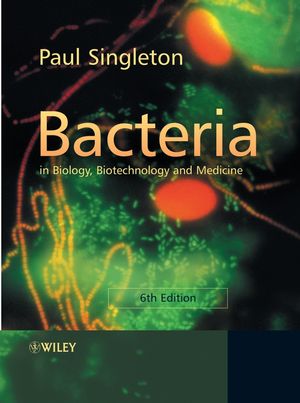Bacteria in Biology, Biotechnology and Medicine, 6th EditionISBN: 978-0-470-09027-5
Paperback
526 pages
October 2004
 This is a Print-on-Demand title. It will be printed specifically to fill your order. Please allow an additional 10-15 days delivery time. The book is not returnable.
|
||||||
1. The bacteria: An introduction.
1.1 What are bacteria?
1.2 Why study bacteria?
1.3 Classifying and naming bacteria.
2. The bacterial cell.
2.1 Shapes, sizes and arrangements of bacterial cells.
2.2 The bacterial cell: A closer look.
2.3 Trichomes and coenocytic bacteria.
3. Growth and reproduction.
3.1 Conditions for growth.
3.2 Growth in a single cell.
3.3 Growth in bacterial populations.
3.4 Diauxic growth.
3.5 Measuring growth.
4. Differentiation.
4.1 The life-cycle of Caulobacter.
4.2 Swarming.
4.3 Resting cells.
4.4 Akinetes, heterocysts, hormogoni.
5. Metabolism I: energy.
5.1 Energy metabolism in chemotrophs.
5.2 Energy metabolism in phototrophs.
5.3 Other topics in energy metabolism.
5.4 Transport systems.
6 Metabolism II: carbon. 6.1 Carbon assimilation in autotrophs.
6.2 Carbon assimilation in heterotrophs.
6.3 Synthesis, interconversion and polymerization of carbon compounds.
6.4 Methylotrophy in bacteria.
7. Molecular biology I: genes and gene expression.
7.1 Chromosomes and plasmids.
7.2 Nucleic acids: Structure.
7.3 DNA replication.
7.4 DNA modification and restriction.
7.5 RNA synthesis: Transcription.
7.6 Proteins: Synthesis and other aspects.
7.7 DNA monitoring and repair.
7.8 Regulation of gene expression.
7.9 RNA.
8. Molecular biology II: changing the message.
8.1 Mutation.
8.2 Recombination.
8.3 Transposition.
8.4 Gene transfer.
8.5 Genetic engineering/recombinant DNA technology.
9. Bacteriophages.
9.1 Virulent phages: The lytic cycle.
9.2 Temperate phages: Lysogeny.
9.3 Androphages.
9.4 Phage conversion.
9.5 Transduction.
9.6 How does phage DNA escape restriction in the host bacterium?
10. Bacteria in the living world.
10.1 Microbial communities.
10.2 Saprotrophs, predators, parasites, symbionts.
10.3 Bacteria and the cycles of matter.
10.4 Ice-nucleation bacteria.
10.5 Bacteriology in situ - fact or fiction?
10.6 The greenhouse effect.
10.7 Recombinant bacteria in the environment.
10.8 Uncultivable/uncultured bacteria.
11. Bacteria in medicine.
11.1 Bacteria as pathogens.
11.2 The routes of infection.
11.3 Pathogenesis.
11.4 The body's defences.
11.5 The pathogen: Virulence factors.
11.6 Pathogen-host interactions: A new perspective.
11.7 The transmission of disease.
11.8 Laboratory detection and characterization of pathogens.
11.9 Prevention and control of transmissible diseases.
11.10 Some notes on chemotherapy.
11.11 Some bacterial diseases.
12. Applied bacteriology I: Food.
12.1 Bacteria in the food industry.
12.2 Food preservation.
12.3 Food poisoning and food hygiene.
13. Applied bacteriology II: Miscellaneous aspects.
13.1 Feeding animals, protecting plants.
13.2 Biomining (bioleaching).
13.3 Biological washing powders.
13.4 Sewage treatment.
13.5 Water supplies.
13.6 Putting pathogens to work.
13.7 Plastics from bacteria: 'Biopol'.
13.8 Bioremediation.
13.9 Biomimetic technology.
14 Some practical bacteriology.
14.1 Safety in the laboratory.
14.2 Bacteriological media.
14.3 Aseptic technique.
14.4 The tools of the bacteriologist.
14.5 Methods of inoculation.
14.6 Preparing a pure culture from a mixture of organisms.
14.7 Anaerobic incubation.
14.8 Counting bacteria.
14.9 Staining.
14.10 Microscopy.
15. Man against bacteria.
15.1 Sterilization.
15.2 Disinfection.
15.3 Antisepsis.
15.4 Antibiotics.
16 The identification and classification of bacteria.
16.1 Identification.
16.2 The classification (taxonomy) of prokaryotes.
Appendix Minidescriptions of some genera, families, orders and other categories of bacteria.
Index.



